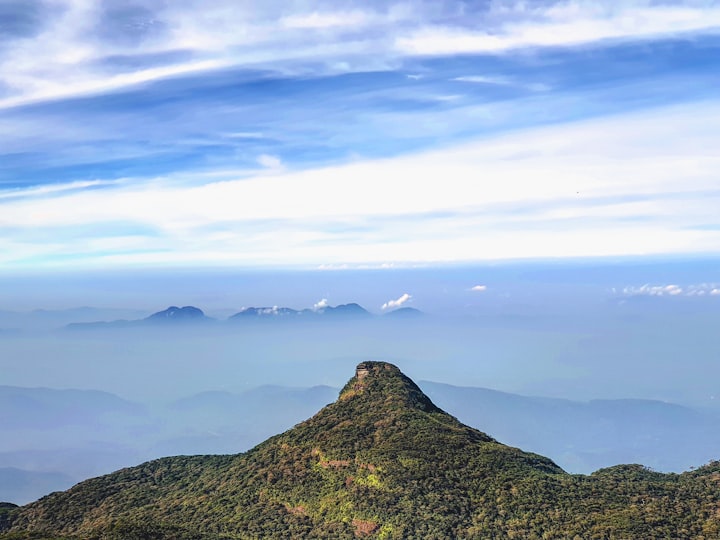Sri pada mountain(Adams peak)
One of the most important history of Sri Lanka

Sri Pada Mountain (Adams Peak)
Sri Pada Temple at the top
The mountain of Sri Pada is one of the rare places that people of four major religions in the world worship. The mountain is situated in the Rathnapura district with a height of 7,360 feet (2,243 meters).
Although this is only the second highest mountains, It rises alone majestically with a conical shape and offers an unobstructed view over land and sea. It is said that the mountain was the landmark of the ancient sea-faring Arabs, who came to Sri Lanka, to trade in gems, spices, ivory etc., and they, having sighted the conical mountain miles off shore, prayed to God for having brought them safely to the island.
According to the Sri Lanka’s great chronicle, Mahawamsa, Buddha visited Sri Lanka three times. The last time he traveled from Kelaniya to Sri Pada, and then to Digavaphi thus consists in the Solosmasthana of Sri Lanka. It is said that Buddha left his foot print on the rock at top of the mountain at the invitation of the Deity Saman (Saman Deviyo).
Deity Saman is recorded as having met the Buddha on his first visit to the island when he visited Mahiyangana to drive away the Tribe of Yakkas. Saman became a stream-entrant (sotapanna) after listening to the Buddha. Deity Saman then requested a object of worship , and Buddha gave him a handful of hairs with which he enshrined on a dagaba at Mahiyangana.
The Theravada Buddhists of Sri Lanka later made Deity Saman the guardian of their land and their religion. With the rise of Mahayana Buddhism, Saman developed into Samantabhadra, one of the four principle bodhisattvas of Mahayana. Like his later manifestation, Samanta is usually depicted crowned and bejewelled, holding a lotus in his right hand and accompanied by a white elephant. At Weligama, an ancient port on Sri Lanka’s south coast, there is a 12 ft high statue which some believe is the figure of Samantabhadra carved out of a huge moss-covered bolder. This statue is now called Kushtarajagala. It is thought that the Pilgrims from India and northern Sri Lanka disembarking at Weligama were greeted by this bodhisattva figure as they set out on the long trek to Sri Pada.
… It is a superficial hollow, five feet three inches and three-quarters long, and between two’ feet seven inches and two feet five inches wide. It is ornamented with a margin of brass, studded with a few gems, of little value: it is covered with a roof, which is fastened to the rock by four iron chains, and supported by four pillars; and it is surrounded by a low wall. The roof was lined with coloured cloths, and its margin being decked with flowers, and streamers, it made a very gay appearance. The cavity .certainly bears a coarse resemblance to the figure of the human foot: were it really ah impression, it is not a very flattering one, or the encomiums which are lavished on the beauty of the feet of Boodhoo are very improperly bestowed. ….
A similar print in Thailand is believed to have the imprint of the Buddha’s right foot, is about five feet long and two feet broad. The real footprint on Adam’s Peak is believed to be set in jewels beneath the visible rock.
The soles of the Buddha’s feet are said to be flat with all the toes of equal length. On each sole there are one hundred and eight auspicious marks (mangala lakkhana), with the wheel (chakra) the principal mark at the centre while around it are grouped figures of animals, inhabitants of various worlds and other kinds of symbols.
Buddhists knew that this mysterious footprint had been made by the Buddha long before (as far as the 1st century BC) any other religion was introduced to the country. But in succeeding centuries other faiths, Islam, Hinduism and Christianity were to lay claim to it. Muslims believe the footprint to be that of Adam (hence the name Adam’s Peak); Christians, that of St. Thomas, the disciple Jesus; and Hindus, that of the god Siva. The Tamil name of the rock Civan-oli-pata (the mountain path of Siva’s light) or Svargarohanam (assent to heaven).
The first historical mention about Sri Pada comes during the reign of Vijayabahu (1055-1110). Earliest historical evidence in chronicles and inscriptions It is recorded that the king having seen the difficulties undergone by the pilgrims on their way to worship the Sri Pathula (Buddha’s Foot Print) on Samanthakuta dedicated the village named ‘Gilimale’ to provide for their needs. Stone inscriptions of Vijayabahu have been found at Gilimale and Ambagamuwa confirming the statement of the chronicle. But it was King Nissanka Malla ( 1187-1196) who reigned from Poona who started the pilgrimage after he ascended the mountain with his fourfold army with great faith and devotion
At the beginning of the 16th century the Portuguese conquered Sri Lanka’s maritime provinces and forbade Buddhists living under their jurisdiction and those coming from overseas from going to Sri Pada. By way of contrast, the king of Kandy in whose realm the mountain was situated, allowed Christians to enter his territory to make the pilgrimage. When the Dutch took over the maritime provinces in 1656 they proved to be less bigoted than the Portuguese but fear that pilgrims might act as spies for the king of Kandy led them, if not to ban, then at least to discourage visits by levying a heavy tax on pilgrims .For nearly two centuries Sinhalese Buddhists living in the low country could see the sacred mountain, worship it from afar but not go there.
In 1581 the crown prince of Kandy murdered his father, King Mayadunne of Sitawaka and proclaimed himself King Rajasinghe I. When he asked the Buddhist monks how he could wash away the wrong deed done by him the monks replied that he cannot getaway from this and he should take responsibility for his action. But the Hindu priests on the other hand were willing to perform a puja to help the king ease his guilty conscience and so he converted to Hinduism. As a result the Buddhist priests were driven off Sri Pada and it was handed to the ‘Andis’ (a non-braminical Siva sect) from South India and they administered it for the next 160 years. Later King Kirti Sri Rajasinha (1747-1781), restored Buddhist ownership, and appointed Ven. Welivitiye Saranankara Sangharaja Maha Thera, to look after Buddhist interests of the holy mountain.He also donated the village, Kuttapitiya and the copper plate charter in support of this donation is still in existence.
Thanks






Comments
There are no comments for this story
Be the first to respond and start the conversation.